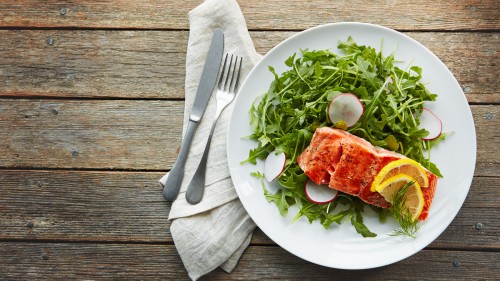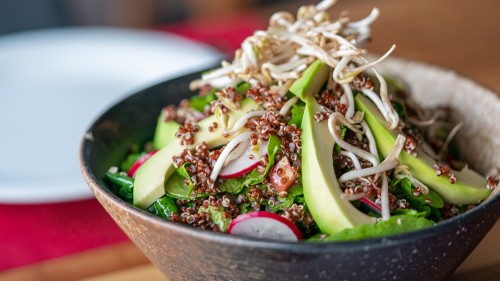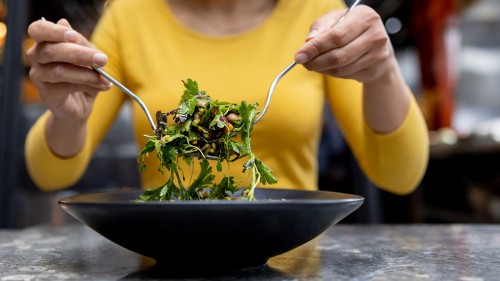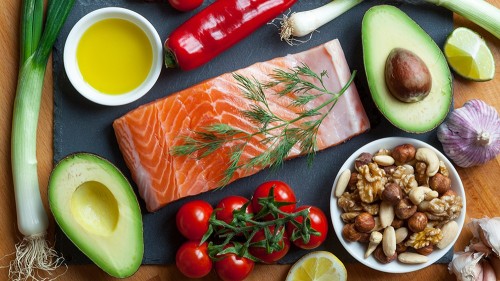Shirataki Noodles 101: A Complete Beginner’s Guide
Published on November 22, 2021
Medically Reviewed by Ana Reisdorf, MS, RD
Shirataki noodles are a type of pasta made from the roots of a plant that grows in parts of Asia. Our dietitian explains everything you need to know about shirataki noodles, including benefits and downsides, nutrient content, ways to cook them, and more.

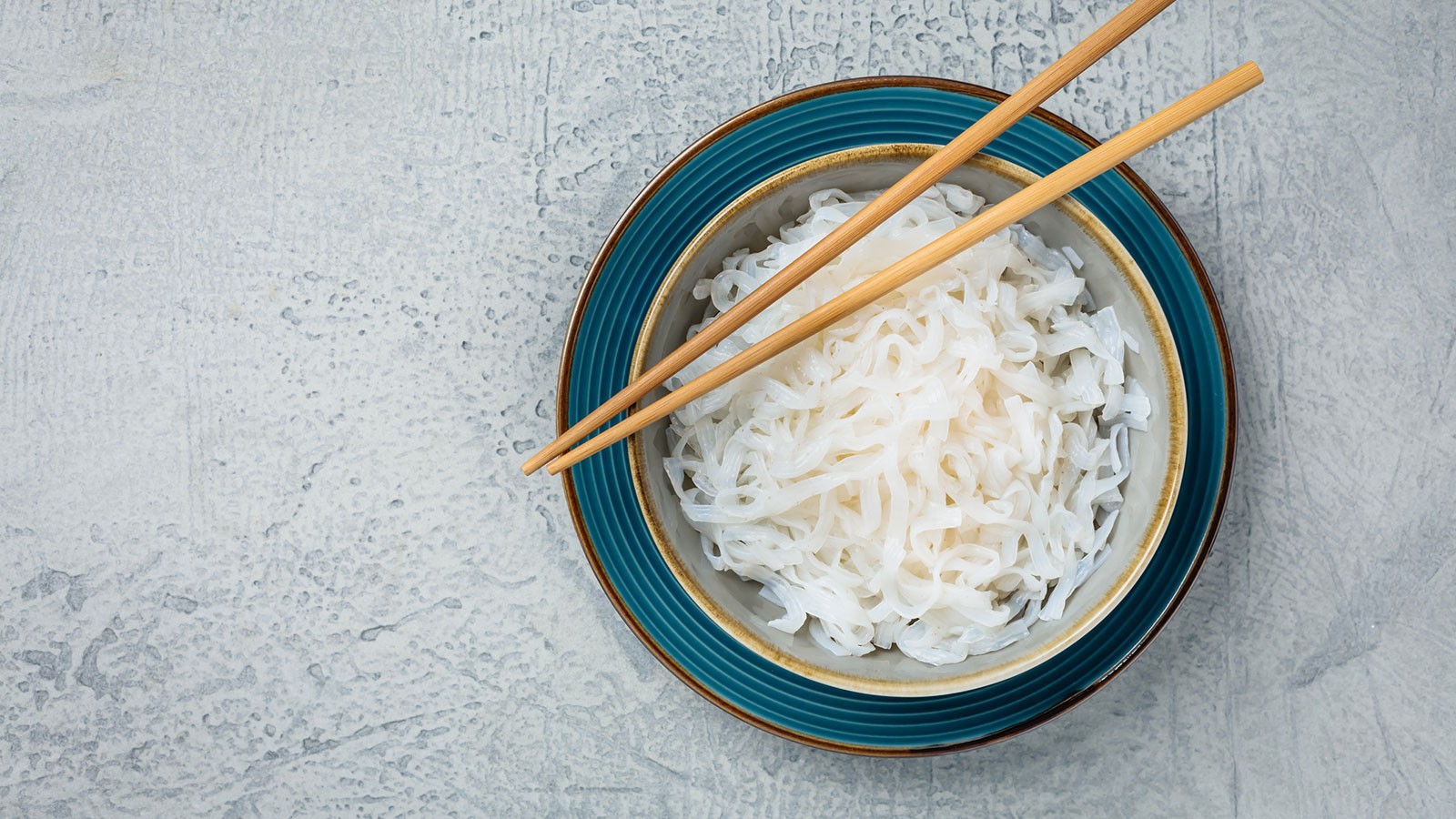
|
Pros
|
Cons
|
What Are Shirataki Noodles?
Shirataki noodles are long, thin noodles that are almost transparent. The name “shirataki” means “white waterfall” in Japanese, which describes how the noodles look when prepared.
While most noodles consumed in western cultures are made using wheat, shirataki noodles are made from glucomannan fiber.
It’s derived from the root of the konjac plant, which grows in various parts of Southeast Asia, China, and Japan.
Nutrient Content
Shirataki noodles only contain a few ingredients. They’re made by combining glucomannan flour with water and lime water. This “dough” is then boiled in water and shaped into noodles.
As for their nutrition content, shirataki noodles are 97% water and 3% glucomannan. They contain very few calories, with fewer than 5–10 calories in a 100-gram serving. (1)
This same serving size contains approximately 3 grams of carbs, 3 grams of fiber, and essentially nothing else.
Shirataki noodles are often marketed as no-calorie noodles. This label can be used because many brands contain 5 calories or fewer in a standard serving size, per FDA regulation. (2)
There’s also a version called tofu shirataki noodles, which are the same product with the addition of tofu in the mixture.
This adds a few calories, a small amount of protein, and potentially some calcium if the tofu was made with calcium sulfate.
Are They Healthy?
While shirataki noodles don’t have much to offer nutritionally, this doesn’t automatically mean they’re unhealthy.
In fact, konjac flour and konjac glucomannan products, like shirataki noodles, are considered a healthy addition to your regular diet in Asia and Europe and are found widely in food markets there. (3)
Still, shirataki noodles contain a few grams of fiber, a handful of calories, and literally nothing else of nutritional value. So, while they’re not necessarily unhealthy, I wouldn’t put them on a list of the most healthful foods either.
I think we need to be careful not to categorize foods like this as “healthy” just because it’s a filling food low in calories.
The glucomannan fiber in traditional shirataki noodles is insoluble, which means it passes through your gastrointestinal tract largely untouched.
Insoluble fiber attracts and absorbs water in your intestines, which can be helpful to alleviate constipation.
Shirataki noodles can be consumed by anyone looking for satiating pasta to incorporate into their diet.
Because of their low-calorie nature and ability to provide some bulking fiber, eating shirataki may be helpful for individuals looking to achieve weight loss goals.
Furthermore, glucomannan has been observed to offer benefits for blood sugar and blood lipids, like high cholesterol and triglycerides, and promote weight loss.
These properties may be beneficial for people with conditions like diabetes or obesity.
Potential Benefits
While there aren’t studies on shirataki noodles specifically, there is research on glucomannan in supplemental form and its potential benefits. Some of these are discussed below.
May Help Support Weight Loss
Shirataki noodles are low in calories and have a satiating effect. (4)
Some research suggests that glucomannan helps delay stomach emptying, making you feel fuller for longer after eating. This may help prevent overeating or eating out of boredom between meals.
Furthermore, when you eat fibrous foods, like shirataki noodles, your intestines ferment it into short-chain fatty acids like butyrate, acetate, and propionate. (5)
This releases hormones that can help increase fullness, and may even reduce levels of the hunger hormone ghrelin. (6)
May Help You Poop
Consuming glucomannan is so effective for constipation that it’s sold specifically as a laxative supplement for both kids and adults.
In one 2004 clinical trial among 31 chronically constipation children, glucomannan supplementation effectively relieved severe constipation among 45% of kids, compared to only 13% of kids in the control group. (7)
The children were given 100 mg/kg body weight daily with 50 mL fluid/500 mg for two 4-week periods.
Plus, even children already using laxatives experienced an improvement when glucomannan supplementation was added to their routine. No significant side effects were observed.
In a small 2008 randomized controlled trial, konjac glucomannan given in doses of 1.5 grams three times per day was found to be beneficial for improving constipation among adults. (8)
In fact, glucomannan increased bowel movements by 30% and improved the fecal microflora, pH, and short-chain fatty acid content of the participants’ colons.
May Help Improve Blood Sugar Control
Ingesting glucomannan has been found to help improve blood glucose and insulin sensitivity among people with diabetes.
In a 2007 clinical trial, researchers provided 20 adults with type 2 diabetes a single dose of 1 gram of glucomannan 30 minutes before a 75 gram glucose load. (9)
Overall, they were given 3 grams of glucomannan per day for four weeks and underwent oral glucose tolerance tests before and after the intervention.
They found that a single dose of glucomannan resulted in significantly lower blood sugar levels in the two hours following their meal, compared to a placebo.
The reason for this is likely because viscous, indigestible fiber like glucomannan delays stomach emptying, which helps slow the rise of blood sugar and insulin response after you eat. (10)
Related: 5 Evidence-Based Ways to Lower Blood Sugar Naturally
May Help Lower Blood Fats
Some studies have found glucomannan to help improve levels of heart health biomarkers, like cholesterol and triglycerides.
In a 2003 clinical trial among 22 individuals with diabetes and high cholesterol levels not currently taking lipid-lowering medications, researchers observed that 3.6 grams per day of glucomannan supplementation effectively reduced total and LDL “bad” cholesterol over two 28-day periods, compared to placebo. (11)
In that study, the participants also underwent a fecal exam, which showed that glucomannan supplementation increased the amount of cholesterol excreted in stool, suggesting that the body absorbed less cholesterol.
And in a 2008 review of 14 studies involving over 500 participants, the authors found that glucomannan supplementation was effective for reducing triglycerides by an average of 11 mg/dL and reducing LDL “bad” cholesterol by an average of 16 mg/dL. (12)
In a more recent 2021 randomized controlled trial, researchers found that adding konjac glucomannan powder to a meal of rice gruel reduced circulating triglyceride levels among 13 healthy Japanese men. (13)
Potential Downsides
I came across no major health or safety risks associated with shirataki noodles in currently available research.
While I couldn’t find research on shirataki noodles specifically, it appears that konjac glucomannan is generally considered non-toxic and non-harmful. (14)
Some people may experience mild digestive complaints from glucomannan like bloating, gas, and loose stools, but this is common with the addition of any new source or amount of fiber in your diet. (15)
A 2013 study aimed to examine the short-term effects of glucomannan supplementation.
The authors found that 3.99 grams of glucomannan given per day for up to eight weeks was safe with no substantial side effects. (16)
Still, they recommend future studies to look at the safety and efficacy of longer-term glucomannan use.
If you haven’t consumed much fiber up to this point, it may be helpful to add it slowly. For instance, try a small amount of shirataki noodles rather than making it a part of your daily diet.
Additionally, underweight or malnourished people should not make them a regular part of their diet, as they can easily fill you up without contributing calories or nutrients.
My main downside to shirataki noodles as a dietitian is that while they can make a good “filler” food, they don’t offer much of anything nutritionally.
How Do You Cook Them and How Do They Taste?
I purchased a single pack of shirataki noodles online, which arrived packaged in a plastic container filled with water.
To prepare them, the directions state to drain them, rinse well, and use in whatever pasta dish you like. The package said they work well in both Asian and western cuisine.
I did a little more research online to see how other people suggested preparing them before I began.
Many said to drain, rinse, and then microwave or pan-fry to remove as much liquid as possible. This was supposed to minimize the rubbery texture and make them more versatile in everyday dishes.
When I opened the package, I noticed an immediate fishy odor. However, it’s important to note that shirataki noodles are vegan and do not contain seafood.
Apparently, this aroma comes from the packaging liquid that has absorbed the smell of konjac root used to make the noodles.
I drained them, rinsed them with running water for about two minutes, and placed them in a small pot with a little bit of olive oil. I heated them for a few minutes.
Shirataki noodles don’t taste like anything and can take on the flavor of pretty much any dressing, sauce, or seasoning you cook them with.
Recommendations from others were to serve with a dressing, sauce, seasoning, or grated cheese.
After I heated them up, I tried them plain. The noodles were difficult to cut due to their rubbery texture, and a slightly fishy odor still remained. I found them to be flavorless and chewy.
I also offered a bite to my children, who said they tasted good despite not liking the original smell.
While you can apparently use shirataki noodles in any of your favorite pasta dishes, I’d personally be most inclined to use them in vegetable stir-fries or a miso and tofu soup.
Cost and Where to Purchase
Shirataki noodles are most accessible in Asian markets or found online. I ordered my plain shirataki noodles from Amazon, which cost $4.99 for an 8.4-ounce package.
As I perused Amazon, though, I noticed there are many other ways to purchase shirataki.
In addition to tofu shirataki, you can find regular shirataki in variety packs that include angel hair, fettuccine, and konjac rice.
I noticed that some brands even sell “odorless” konjac noodles. There are also shirataki products that contain other ingredients, like konjac spaghetti with oat flour added to improve texture.
Many of these are priced around $20.00 for a pack of 6–8, coming out to $0.30–$0.38 per ounce of pasta.
For comparison, rice noodles are priced between $0.20–$0.50 per ounce, and traditional spaghetti falls into the $0.10–$0.20 per ounce range.
Comparison to Alternatives
Probably the closest comparison to shirataki noodles, in terms of flavor and texture, is cooked rice noodles. It seems like the two can be used in similar ways.
Nutritionally, rice noodles are higher in calories and contain a variety of micronutrients, albeit in minimal amounts.
For instance, a 100-gram serving of cooked rice noodles provides 100 calories, 2 grams of protein, 24 grams of carbs, and 1 gram of fiber. (17)
There are no other similar “zero-calorie” noodles available on the market.
Frequently Asked Questions About Shirataki Noodles
What are shirataki noodles made of?
Shirataki noodles are mostly made of water, and their main ingredient is glucomannan fiber, which comes from the root of the konjac plant.
To make them, glucomannan is combined with water and lime water, boiled, and shaped into noodles or rice.
Where do you buy shirataki noodles?
You can buy shirataki noodles at most Asian or Japanese markets. They’re also easy to find online in places like Amazon.
Do shirataki noodles have calories?
Shirataki noodles generally contain 5 calories or fewer in a standard serving size, which allows it to carry a “calorie-free” or “no calorie” label per FDA regulations.
Overall, the calories in shirataki noodles are negligible.
How do you eat shirataki noodles?
To prepare shirataki noodles, open their packaging, drain the liquid, and rinse them thoroughly with water to remove the odor.
While they’re ready to eat now, you can also heat them in the microwave or sauté them in a pan before adding them to dishes or covering them with a flavorful dressing or sauce.
Are shirataki noodles good for you?
Shirataki noodles are very low in calories and offer a small amount of fiber. Otherwise, they offer little to no nutritional value.
While they may be a helpful food for satiety, particularly in a weight loss diet, they do not contribute healthful nutrients.
What are the best brands of shirataki noodles?
There isn’t one specific brand that shines above the rest for shirataki noodles, as they all are basically the same.
Miracle Noodle offers different shapes of shirataki noodles and even glucomannan rice.
Noodle Zero offers several different flavors, such as beef or Tom Yum.
Finding the right noodle brand for you might take a bit of trial and error.
The Bottom Line
Shirataki noodles are a very low-calorie food that many people enjoy substituting for other types of pasta. Its lack of strong taste allows it to take on just about any flavor.
Just note that shirataki does have a strong fishy smell when you open a new package, which is mostly removed by thoroughly rinsing before you prepare them.
Research on the insoluble fiber used to make shirataki, called glucomannan, suggests that this food may be helpful for people who want to lose weight and potentially improve blood sugar control and blood fats like cholesterol and triglycerides.
While shirataki noodles may be a helpful “filler” food for someone on a low-calorie diet, they don’t provide much nutritional value.
If someone is looking into these “miracle noodles” to promote weight loss, I would say they can certainly be incorporated but shouldn’t make up a large portion of their diet due to the lack of nutrients.
Instead, I would prioritize whole plant foods and avoiding ultra-processed items to aid in sustainable weight loss goals.
At WellnessVerge, we only use reputable sources, including peer-reviewed medical journals and well-respected academic institutions.
- USDA, Agricultural Research Service FoodData Central: SHIRATAKI NOODLES:
https://fdc.nal.usda.gov/fdc-app.html#/food-details/1976533/nutrients - CFR - Code of Federal Regulations Title 21:
https://www.accessdata.fda.gov/scripts/cdrh/cfdocs/cfcfr/CFRSearch.cfm?fr=101.60#: - Health-promoting effects of konjac glucomannan and its practical applications: A critical review:
https://pubmed.ncbi.nlm.nih.gov/30586587/ - Effects of dietary fibre on subjective appetite, energy intake and body weight: a systematic review of randomized controlled trials:
https://pubmed.ncbi.nlm.nih.gov/21676152/ - Neuropeptides and the Microbiota-Gut-Brain Axis:
https://www.ncbi.nlm.nih.gov/pmc/articles/PMC4359909/ - Immediate and long-term effects of glucomannan on total ghrelin and leptin in type 2 diabetes mellitus:
https://pubmed.ncbi.nlm.nih.gov/19108925/ - Fiber (glucomannan) is beneficial in the treatment of childhood constipation:
https://pubmed.ncbi.nlm.nih.gov/14993586/ - Supplementation of konjac glucomannan into a low-fiber Chinese diet promoted bowel movement and improved colonic ecology in constipated adults: a placebo-controlled, diet-controlled trial:
https://pubmed.ncbi.nlm.nih.gov/18460488/ - Glycemic and lipid responses to glucomannan in Thais with type 2 diabetes mellitus:
https://pubmed.ncbi.nlm.nih.gov/18041436/ - The impact of soluble dietary fibre on gastric emptying, postprandial blood glucose and insulin in patients with type 2 diabetes:
https://pubmed.ncbi.nlm.nih.gov/24901089/ - Konjac supplement alleviated hypercholesterolemia and hyperglycemia in type 2 diabetic subjects--a randomized double-blind trial:
https://pubmed.ncbi.nlm.nih.gov/12569112/ - Effect of glucomannan on plasma lipid and glucose concentrations, body weight, and blood pressure: systematic review and meta-analysis:
https://pubmed.ncbi.nlm.nih.gov/18842808/ - Konjac Glucomannan Attenuated Triglyceride Metabolism during Rice Gruel Tolerance Test:
https://pubmed.ncbi.nlm.nih.gov/34202167/ - Konjac glucomannan, a promising polysaccharide of Amorphophallus konjac K. Koch in health care:
https://pubmed.ncbi.nlm.nih.gov/27481345/ - Glucomannan and obesity: a critical review:
https://pubmed.ncbi.nlm.nih.gov/16320857/ - Safety and Efficacy of Glucomannan for Weight Loss in Overweight and Moderately Obese Adults:
https://www.ncbi.nlm.nih.gov/pmc/articles/PMC3892933/ - USDA, Agricultural Research Service FoodData Central: Rice noodles, cooked:
https://fdc.nal.usda.gov/fdc-app.html#/food-details/1101528/nutrients


